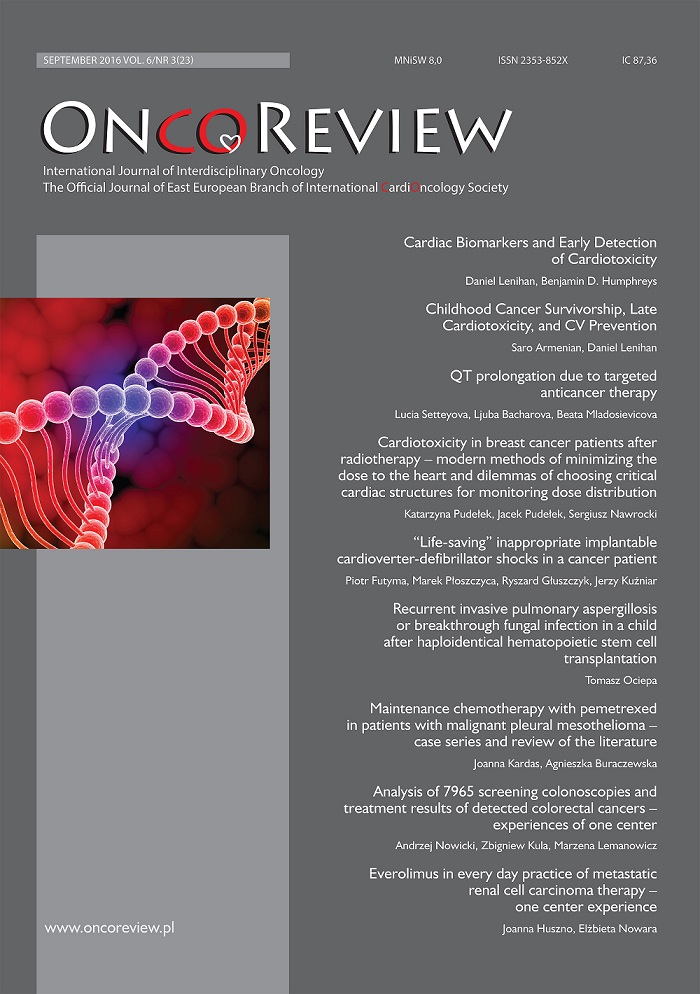Everolimus in every day practice of metastatic renal cell carcinoma therapy – one-center experience Original article
Main Article Content
Abstract
Introduction: Everolimus is a selective mTOR inhibitor which received approval for treatment of advanced renal cell carcinoma (mRCC) after progression on or after treatment with VEGF-targeted therapy.
The aim of this study was to evaluate the efficiency and toxicity profile of everolimus in second line therapy of mRCC. The authors also assessed the impact of clinicopathological factors on the effectiveness of everolimus.
Methods: The retrospective analysis was conducted on the medical records of 33 mRCC patients who were treated with everolimus in second line therapy after progression on interferon or tyrosine kinase inhibitors (sunitinib or pazopanib) during the years 2010–2016.
Results: Median time of treatment with everolimus was 4 months (range from 1 to 58 months). Median progression free survival was 4 months and overall survival (OS) was 11 months. The best response (PR + CR + SD) was reported in 57% of patients. Toxicity in grade 3–4 was reported in 9 (27%) of patients. Clinicopathological factors associated with progression during everolimus therapy were: smoking and alcohol abuse (p = 0.029), higher Furman grade (p = 0.166), tumor necrosis (p = 0.383), fat tissue infiltration (p = 0.040), lymph node (p = 0.193) and adrenal metastases (p = 0.067). Factors which increase the risk of everolimus toxicity were worse performance status (p = 0.333) and more advanced disease at the beginning (lymph nodes metastases, p = 0.05) and higher Furman grade (p = 0.04).
Conclusions: Cigarettes use and/or alcohol abuse, adrenal metastases, fat tissue had significantly negative influence on survival. Grade 3–4 toxicity were reported more frequently in patients with worse performance status and more advanced disease at the time of diagnosis.
Downloads
Metrics
Article Details

This work is licensed under a Creative Commons Attribution-NonCommercial 4.0 International License.
Copyright: © Medical Education sp. z o.o. This is an Open Access article distributed under the terms of the Attribution-NonCommercial 4.0 International (CC BY-NC 4.0). License (https://creativecommons.org/licenses/by-nc/4.0/), allowing third parties to copy and redistribute the material in any medium or format and to remix, transform, and build upon the material, provided the original work is properly cited and states its license.
Address reprint requests to: Medical Education, Marcin Kuźma (marcin.kuzma@mededu.pl)
References
2. Gomez-Pinillos A, Ferrari AC. mTOR Signaling pathway and mTOR inhibitors in cancer therapy. Hematol Oncol Clin North Am 2012; 26 (3): 483-505.
3. Laplante M, Sabatini DM. mTOR Signaling in growth control and disease. Cell 2012; 149 (2): 274-293.
4. Online: mTOR Inhibitors: EVEROLIMUS, TEMSIROLIMUS. www.d.umn.edu/~jfitzake/Lectures/DMED/Antineoplastics/AngiogenesisInhibitors/mTORInhibitorsMechanism.html .
5. Keith CT, Schreiber SL: PIK-related kinases: DNA repair, recombination, and cell cycle checkpoints. Science 1995; 270: 50-51.
6. Hara K, Maruki Y, Long X et al. Raptor, a binding partner of target of rapamycin (TOR), mediates TOR action. Cell 2002; 110: 177-189.
7. Loewith R, Jacinto E, Wullschleger S et al. Two TOR complexes, only one of which is rapamycin sensitive, have distinct roles in cell growth control. Mol Cell 2002; 10:457-468.
8. Online: http://www.ema.europa.eu/docs/pl_PL/document_library/EPAR_-_Product_Information/human/001038/WC500022814.pdf .
9. Coppin Ch. Everolimus: the first approved product for patients with advanced renal cell cancer after sunitinib and/or sorafenib. Biologics 2010; 4: 91-101.
10. Tsukamoto T, Shinohara N, Tsuchiya N et al. Phase III trial of everolimus in metastatic renal cell carcinoma: subgroup analysis of Japanese patients from RECORD-1. Jpn J Clin Oncol 2011; 41: 17-24.
11. Motzer RJ. RECORD-4: A multicenter, phase II trial of second-line everolimus (EVE) in patients (pts) with metastatic renal cell carcinoma (mRCC). 2015 ASCO Annual Meeting. J Clin Oncol 2015; 33 (suppl; abstr 4518).
12. Goebel PJ, Kube U, Staehler M et al. Everolimus as second-line therapy for metastatic renal cell carcinoma (mRCC) after one previous VEGF-targeted therapy: Final results of the noninterventional change study. J Clin Oncol 2014; 32 (suppl 4; abstr 469).
13. Wong MK, Yang H, Signorovitch JE et al. Comparative outcomes of everolimus, temsirolimus and sorafenib as second targeted therapy for metastatic renal cell carcinoma: a US medical records review. Curr Med Res 2014; 30: 537-545.
14. Albiges L, Kube U, Eymard JC et al. Everolimus for patients with metastatic renal cell carcinoma refractory to anti-VEGF therapy: results of a pooled analysis of non-interventional studies. Eur J Cancer. 2015; 51: 2368-2374.
15. Rizzo M, Facchini G, Savastano C et al. Ewerolimus w leczeniu drugiej linii zaawansowanego raka nerkowokomórkowego: badanie w warunkach codziennej praktyki lekarskiej. Future Oncol 2014 https://doi.org/10.2217/FON.14.170.
16. Conteduca V, Santoni M, Medri M et al. Correlation of stomatitis and cutaneous toxicity with clinical outcome in patients with metastatic renal-cell carcinoma treated with everolimus. Clin Genitourin Cancer 2016 pii: S1558-7673(16)30040-4, https://doi.org/10.1016/j.clgc.2016.02.012.
17. Wong MK, Jonasch E, Pal SK et al. Prognostic factors for survival following initiation of second-line treatment with everolimus for metastatic renal cell carcinoma: evidence from a nationwide sample of clinical practice in the United States. Expert Opin Pharmacother 2015; 16: 805-819 https://doi.org/10.1517/14656566.2015.1020298.
18. Atkinson BJ, Cauley DH, Ng C et al. Mammalian target of rapamycin (mTOR) inhibitor-associated non infectious pneumonitis in patients with renal cell cancer: predictors, management, and outcomes. BJU Int 2014; 113: 376-82 https://doi.org/10.1111/bju.12420.
19. Kim KH, Kim JH, Lee JY et al. Efficacy and Toxicity of Mammalian Target Rapamycin Inhibitors in Patients with Metastatic Renal Cell Carcinoma with Renal Insufficiency: The Korean Cancer Study Group GU 14-08. Cancer Res Treat 2016 https://doi.org/10.4143/crt.2016.018, epub ahead of print.
20. Park I, Lee JL, Ahn JH et al. Vascular endothelial growth factor receptor tyrosine kinase inhibitor (VEGFR-TKI) rechallenge for patients with metastatic renal cell carcinoma after treatment failure using both VEGFR-TKI and mTOR inhibitor. Cancer Chemother Pharmacol 2015; 75: 1025-1035 https://doi.org/10.1007/s00280-015-2725-8 .

